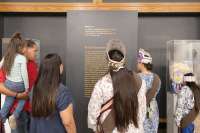The story behind the storyteller
Lloyd Arneach likes to make people cry.
“That means they understand the stories I am telling,” said Arneach, a 68-year-old storyteller from Cherokee. “A superb storyteller in one program can make you laugh, make you think and move you to tears.”
Arneach’s story starts in the 1970s in Georgia with a request from his children’s babysitter. She could not find any books about American Indians to present to an area Girl Scout Troop and so asked Arneach to speak to them.
At the time, he worked as a computer programmer, and when he arrived at the meeting, he sat casually in his three-piece suit as the girls anxiously awaited the appearance of a real-life Indian in full regalia.
“When I started talking to them, their jaws dropped,” Arneach said.
That first appearance turned into a second Girl Scout gig, until Arneach eventually found himself telling stories at Georgia Tech, the John F. Kennedy Center for the Performing Arts and the opening of the National Museum of the American Indian.
Related Items
“It’s been incredible all the places storytelling has taken me,” he said.
One such place was the Festival of Fires, an all-Indian event during the Olympics in Atlanta where he met record-breaking Olympian Billy Mills, the only American ever to win a gold medal in the 10,000-meter run.
“Billy Mills to me is what an Olympic champs should be,” Arneach said, calling him a gracious individual.
People seem willing to hand parts of their lives to Arneach, who preserves each memory.
A friend dressed in traditional Indian garb once told Arneach about speaking at a large event in Washington when a woman approached, asking who his people were and asking to take his picture. Come to find out, the woman was former Supreme Court Justice Sandra Day O’Connor.
“It’s amazing the people who have sat and shared stories with me,” he said. “I feel very blessed the stories that have come to me.”
Arneach continued working as a computer programmer but told stories part-time. However, he eventually realized that most of his vacation time was spent guest-speaking at various festivals and events.
In 1993, Arneach, who had left Cherokee when he was 21, moved back to the reservation and became a full-time storyteller.
An Emotional Journey
There are several key components to the perfect storytelling experience.
“The sitting has to be correct,” Arneach said. “The audience has to be right.”
The venue must be silent, without the possibility of outside noise to detract from the performance, and the audience must be engaged. With these elements intact, Arneach need only gauge the crowd with one or two starter tales and then decide which narratives will receive the best response — should he stick to more lighthearted fare or is the audience emotionally ready to follow him into a more serious story.
“I never have a schedule when I go in story telling,” he said.
People are encouraged to relay the stories Arneach tells. Anecdotes are meant to be passed on, not hoarded in one’s memory, said Arneach, who is afraid that the art of storytelling will die with the older generations.
He tells a mixture of cultural and personal stories. Arneach chuckled as he recalled a visit to a 7-Eleven gas station. He had stopped at the convenience store earlier in the day.
He returned a second time, and the men working there asked his ethnicity. When they heard he was Native American, the men excitedly exclaimed ‘Wow, two in one day,’ not realizing that Arneach was the Native American from earlier.
His favorite story to tell, however, is Chief Joseph and the flight of the Nez Perce.
After attempting to resist efforts by U.S. soldiers to forcibly remove the tribe from its native lands in the 1800s, the band of Nez Perce fled to safety in Canada.
“I do not understand why that story affects me more than most,” Arneach said.
He requires about an hour to tell the story, but once he’s done, he cannot tell anymore.
“I am emotionally wiped out — both emotionally and physically,” Arneach said.
Hear him for yourself
Who: Lloyd Arneach
Where: Haywood County Public Library in Waynesville
When: 3 p.m., Jan. 16









